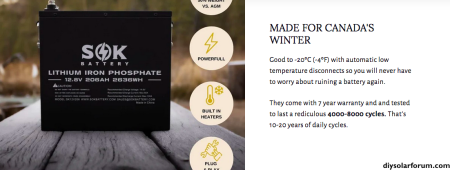bajajoaquin
New Member
- Joined
- Sep 1, 2021
- Messages
- 46
This is not really a lithium DIY question, but I’m looking at putting together a heater and thermocouple for a lithium battery so it’s kinda DIY.
Anyway, I’m looking at the SOK 100ah battery for a friend who wants to cold weather boondock camp. My understanding of the SOK is that it draws the current for heating from the power source (solar, in this case) rather than from the battery. The theory is that it means it won’t try to charge until it’s heated itself up enough to work. However, on a system where it’s not plugged in all night, it seems to me that the battery temp could drop below the cold weather discharge threshold and then there could be no power at all.
If this is the case, a heated battery wouldn’t provide the over night operation that is required. I’d still be having to put a low wattage heating pad and thermocouple in the compartment anyway, right? That seems to indicate that I shouldn’t bother with a heated battery.
Thoughts?
Anyway, I’m looking at the SOK 100ah battery for a friend who wants to cold weather boondock camp. My understanding of the SOK is that it draws the current for heating from the power source (solar, in this case) rather than from the battery. The theory is that it means it won’t try to charge until it’s heated itself up enough to work. However, on a system where it’s not plugged in all night, it seems to me that the battery temp could drop below the cold weather discharge threshold and then there could be no power at all.
If this is the case, a heated battery wouldn’t provide the over night operation that is required. I’d still be having to put a low wattage heating pad and thermocouple in the compartment anyway, right? That seems to indicate that I shouldn’t bother with a heated battery.
Thoughts?



